 |
| 2024 solar eclipse | Credit: NASA Keegan Barber |
On Monday, April 8, 2024, a total solar eclipse moved across North America, passing over Mexico, the United States, and Canada. During the event, the moon’s shadow moved across the region from the southwest toward the northeast.
In the Great Lakes region, the eclipse path of totality included parts of Ohio, Pennsylvania, New York, Southern Ontario.
The eclipse continued through Quebec, New Brunswick, Prince Edward Island, and Cape Breton. The eclipse exited continental North America on the Atlantic coast of Newfoundland, Canada, at 5:16 p.m. NDT.
Some of the most popular locations for viewing the 2024 total solar eclipse were located along the southern shores of Lake Erie and Lake Ontario.
The eclipse drew large crowds of enthusiasts to the region. Cities such as Toledo, Cleveland, Erie, and Buffalo were in the prime viewing area. Festivals and special events were held in almost every city.
Total Eclipse Fest 2024 was held at Great Lakes Science Center in Cleveland. The Science Center and its partners NASA’s Glenn Research Center and The Cleveland Orchestra partnered in a three day celebration.
Eclipse enthusiasts also watched the event at Cuyahoga Valley National Park and other public spaces.
Near Buffalo New York, crowds gathered at Buffalo Harbor State Park, Niagara Falls State Park, Whitworth Ferguson Planetarium at Buffalo State College, Explore & More Children’s Museum, Niagara Falls USA, Buffalo Audubon Society – Beaver Meadow Nature Center, Knox Farm State Park, Buffalo and Erie County Naval & Military Park, and other locations.
In the Lake Ontario area, the Rochester Museum & Science Center (RMSC) hosted a three day ROC the Eclipse at the RMSC event.
Other areas for viewing the eclipse near Rochester included Parcel 5 in Downtown Rochester, Ontario Beach Park (along Lake Ontario), Cobbs Hill Park (closed to cars), Highland Park, Genesee Valley Park, High Falls, Durand Eastman Park, Mendon Ponds Park, Webster Park, Perinton Town Park, Hamlin Beach State Park, Black Creek Park, Churchville Park, Greece Canal Park, and Northampton Park.
Information about viewing solar eclipses safely is available from NASA and other numerous online resources.



